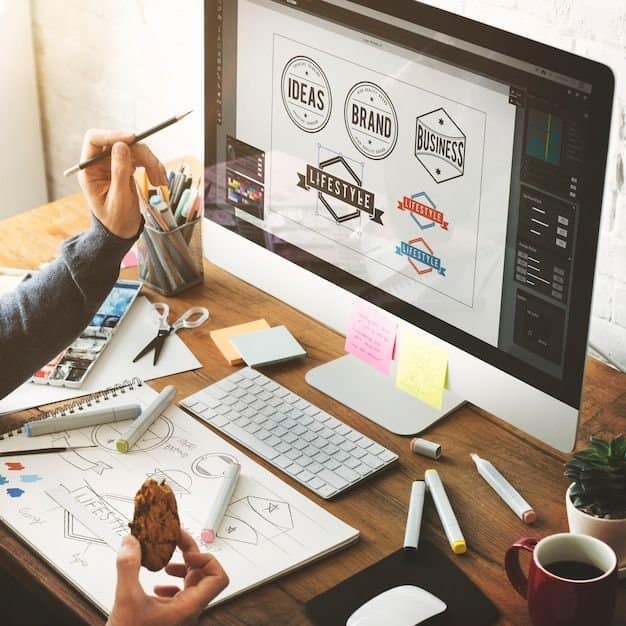Mastering Graphic Design: Visual Communication
Dipublikasikan oleh Mawar pada
Mastering Graphic Design: Visual Communication
Graphic design is the art and practice of creating visual communications that can be delivered through various media, such as posters, advertisements, product packaging, websites, and more. Graphic design combines visual elements like text, images, colors, and shapes to convey a clear and engaging message. This article will cover several key aspects of graphic design, including basic design elements, types of graphic design, and the latest trends in the field.
1. Basic Elements of Graphic Design
These elements form the foundation of every graphic design piece, creating effective visual compositions:
Line: Lines can be used to separate, guide the viewer’s eye, or provide form and direction within the design.
Shape: A shape is a two-dimensional area used to create objects or visual patterns.
Color: Color not only affects aesthetics but can also communicate emotions or specific meanings. Choosing the right colors is crucial in graphic design.
Typography: The selection of fonts, sizes, and spacing (kerning) is essential in graphic design to effectively communicate a message.
Negative Space: Using empty space can emphasize other design elements and create visual balance.
Texture: Texture adds visual dimension and can create a specific feel in a design.
2. Types of Graphic Design
Graphic design is not limited to one specific field; here are some common types of graphic design:
Branding Design: Branding is how a brand creates its visual identity. Graphic design plays a key role in crafting logos, color palettes, and other visual elements that represent a company.
Advertising Design: Visual advertisements, both print and digital, aim to attract the audience’s attention and convey a persuasive message.
Packaging Design: Packaging design focuses on creating appealing and functional product packaging. Well-designed packaging can enhance product value and differentiate it from competitors.
Web Design: Graphic design for websites involves layout, visual elements, and user experience (UX) to make websites easy to navigate and visually appealing.
Illustration Design: Illustration can add visual interest to graphic design, whether through hand-drawn or digital illustrations.
3. The Graphic Design Process
The graphic design process can vary, but generally includes the following stages:
Understanding the Brief: Grasping the client’s or project’s needs, including goals, target audience, and the message to be conveyed.
Research: Gathering inspiration and understanding current design trends and the target market’s characteristics.
Sketching and Initial Concepts: Creating rough designs or initial concepts to develop further.
Designing and Refining: Using design software to create the final version of the design and refining it based on client feedback or team input.
Presentation and Production: Presenting the final design to the client and preparing the files for print or digital use.
4. Latest Graphic Design Trends
Graphic design continues to evolve with technological advancements and shifts in audience preferences. Some of the current trends in graphic design include:
Minimalist Design: Emphasizing simplicity and using more negative space to create clean, easily understood designs.
Web Illustration: The use of expressive and creative illustrations is becoming popular in website and app design.
Gradients and Bright Colors: Gradients and bright color palettes are making a comeback, giving designs a dynamic and energetic appearance.
3D Design and Animation: The use of 3D effects and animation adds new dimensions to graphic design, particularly in digital media and advertising.
5. Graphic Design Tools and Software
Modern graphic designers often use software tools to help create their work. Some of the most commonly used graphic design software includes:
Adobe Photoshop: Used for image editing and photo manipulation.
Adobe Illustrator: Used to create vector illustrations, such as logos and icons.
CorelDRAW: An alternative vector design tool often used by professional graphic designers.
Figma: A web-based design tool popular for UI/UX design and prototyping.
6. Challenges and Opportunities in Graphic Design
The graphic design industry offers many opportunities but also presents challenges. Intense market competition, rapid technological changes, and increasingly demanding clients are some of the challenges designers face. However, with boundless creativity and the ability to adapt to new trends and technologies, graphic designers can achieve success and produce innovative works that captivate audiences.
Conclusion:
Graphic design is a continuously evolving field that blends creativity with technology to create effective visual communication. By understanding the basic elements of design, types of graphic design, and the tools used, anyone can create designs that influence their audience and achieve communication goals more effectively. By staying updated on trends and honing their skills, graphic designers can unlock new opportunities in this dynamic industry.

0 Komentar